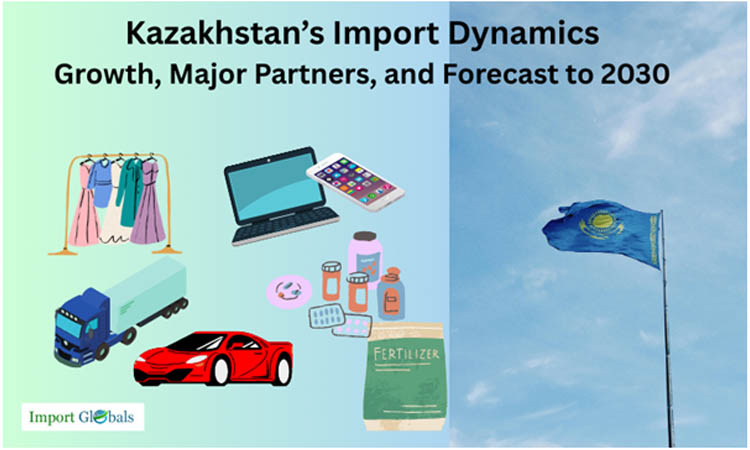
- Aug 12, 2025
Kazakhstan’s Import Dynamics: Growth, Major Partners, and Forecast to 2030
Its economy is resource-rich and mostly depends on exports of minerals, oil, and gas. As per Kazakhstan Import Data by Import Globals, to support consumer markets, infrastructure, and technical growth, its domestic industrial base nonetheless needs a range of imported commodities. Important information on Kazakhstan's strategic trade policy and economic dependencies can be gained by analyzing its import data.
As per Kazakhstan Export Data by Import Globals, due to its advantageous geographic location bordering China, Russia, and numerous Central Asian republics, Kazakhstan, a large Central Asian country rich in natural resources, is an important player in the regional economy. Kazakhstan maintains a strong import profile to fund its expanding domestic consumption and infrastructure modernization initiatives, despite its economy being highly focused on exports, particularly in the areas of minerals, oil, and gas. Over the past ten years, the nation's reliance on imported goods, particularly machinery, automobiles, and electronics, has increased significantly as it continues to advance industrially and technologically.
General Economic Indicators of Kazakhstan
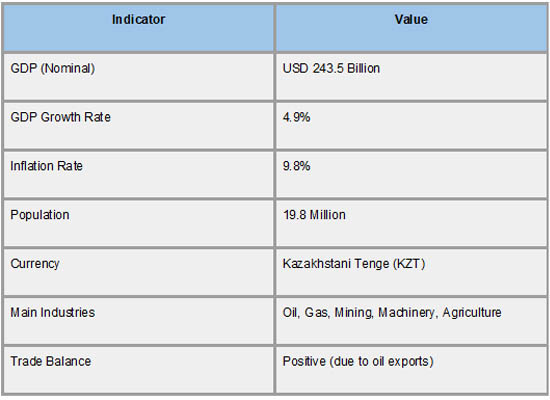
Kazakhstan's economy, which had a nominal GDP of USD 243.5 billion in 2023 and a consistent GDP growth rate of 4.9%, is still among the most dynamic in Central Asia. Strong success in the oil and gas industry, bolstered by favorable global commodity prices and expanded production capacity, has been the main driver of this expansion. As per Kazakhstan Import Export Trade Data By Import Globals, the nation's significant oil exports, which remain the foundation of its economic structure, are the main reason for its favorable trade balance. Kazakhstan has demonstrated resilience in labor markets and consistent industrial output by maintaining macroeconomic stability and a comparatively low unemployment rate of 4.8% in the face of global problems.
In 2023, the inflation rate was 9.8%, driven by changes in food prices and disruptions in the global supply system. Kazakhstan, which is expected to have 19.8 million people by 2024, is steadily growing its consumer base, which is raising demand for foreign goods and services. The Kazakhstani Tenge (KZT), the country's currency, is still comparatively stable while being vulnerable to outside shocks because of its trade dependence. The economy is dominated by core industries like mining, oil, gas, agriculture, and equipment, which also set the tone for both domestic and foreign trade policy. Together, these metrics show Kazakhstan's economy is expanding and has a lot of potential, even if it still depends on foreign markets for essential consumer and industrial inputs.
Kazakhstan Import Data
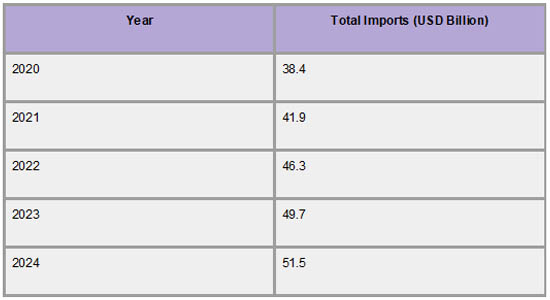
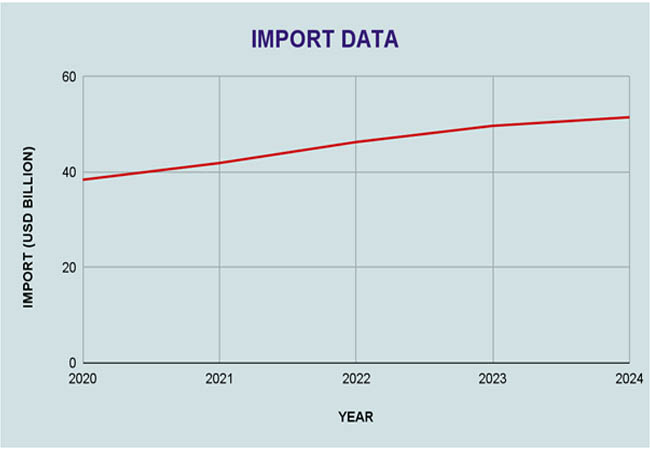
Over the last five years, Kazakhstan's import volume has steadily increased, indicating the nation's rising need for imported commodities as it continues its economic modernization and growth initiatives. As per Kazakhstan Import Custom Data by Import Globals, the global slowdown brought on by the COVID-19 epidemic had an impact on the $38.4 billion total imports in 2020. But the recovery was quick; by 2021, imports had grown to $41.9 billion due to a combination of infrastructural construction, resurgent industry, and growing consumer demand as pandemic restrictions relaxed.
As per Kazakhstan Import Trade Analysis by Import Globals, the following years saw this increasing trend continue, with 2022 seeing a notable spike to USD 46.3 billion and 2023 reaching USD 49.7 billion. The projected amount for 2024 is USD 51.5 billion, which is a nearly 34% increase from 2020. The main causes of this consistent increase in imports include Kazakhstan's emphasis on consumer market diversity, transportation improvements, and technical innovation. The rising import bill also shows how dependent the nation is on outside vendors for essential parts needed for its growing industrial base, such as chemicals, electronics, autos, and machinery.
Major Import Partners of Kazakhstan


Russia and China are Kazakhstan's two biggest import partners, and the country's geopolitical location and historical commercial relations have a significant impact on its import network. A significant portion of Kazakhstan's overall imports in 2024 came from Russia, which brought in almost $17.2 billion. As per Kazakhstan Export Data by Import Globals, construction materials, automobiles, petroleum, and industrial gear are just a few of the many products that Russia supplies. This trade relationship is further strengthened by the proximity, shared infrastructure, and involvement in regional economic unions like as the Eurasian Economic Union (EAEU). With $10.8 billion in 2024, China ranks as Kazakhstan's second-largest import partner. It supplies vital electronics, textiles, heavy machinery, and consumer items, making a substantial contribution to Kazakhstan's consumer and technology industries.
In addition to its two biggest trading partners, Kazakhstan imports substantial amounts from South Korea ($2.1 billion), Germany ($4.1 billion), and Turkey ($2.7 billion), demonstrating its increasing trade diversification with international actors. Pharmaceuticals, chemicals, electronics, and transportation equipment are the main exports from these countries to Kazakhstan. As per Kazakhstan Import Data by Import Globals, with contributions of $1.9 billion and $1.5 billion, respectively, the US and Uzbekistan are also becoming partners. These connections demonstrate Kazakhstan's attempts to increase its international trade presence and lessen its undue reliance on a small number of neighbors. A strategic shift toward improving trade security and gaining access to superior, cutting-edge items from a wider range of suppliers is shown by the changing network of import partners.
Major Import Product Categories
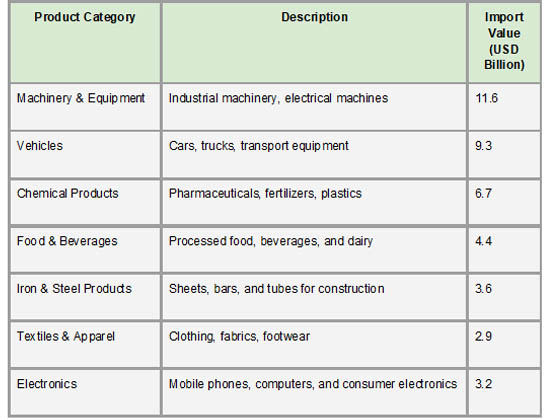
Kazakhstan's growing consumer base and continuous modernization are reflected in its main import product categories. With an estimated USD 11.6 billion in 2024, machinery and equipment, which includes mechanical appliances, electrical generators, and industrial gear, top the list. As per Kazakhstan Import Trade Statistics by Import Globals, following closely behind at USD 9.3 billion are vehicles, including trucks, passenger cars, and spare parts, which support both private consumption demands and public infrastructure. At $6.7 billion, chemical products, such as plastics, fertilizers, and medications, represent another crucial area that is necessary for the nation's healthcare and agricultural industries. At $4.4 billion, food and beverage imports show a growing desire for luxury goods and processed foods.
Topmost Import Product and Partner
As per Kazakhstan Import Shipment Data by Import Globals, the gear and equipment, including mechanical appliances, electrical generators, and industrial gear, are Kazakhstan's top imports. This sector made up a sizable amount of the nation's overall imports in 2024, totaling about USD 25.6 billion. These imports are crucial to Kazakhstan's infrastructure development, technological improvement, and industrial expansion.
With imports totaling $18.2 billion USD in 2024, an 8.3% rise over the previous year, Russia was Kazakhstan's main import partner. As per the Kazakhstan Import Export Trade Analysis by Import Globals, this expansion demonstrates how the two countries' economic relations have grown stronger. A vast array of products, including machinery, automobiles, petroleum, and building supplies, is sent by Russia to Kazakhstan and is essential to the country's infrastructure and manufacturing industries.
Strategic Implications of Kazakhstan’s Import Trends
Kazakhstan's increasing reliance on imports, especially from powerful allies like China and Russia, has significant strategic ramifications for its geopolitical positioning and economic sovereignty. Although these robust economic linkages make it easier to obtain the consumer products, machinery, and technology needed for local growth, they also put Kazakhstan at risk from supply chain interruptions, external sanctions, and changes in regional politics. As per Kazakhstan Export Import Global Trade Data by Import Globals, Kazakhstan must therefore strike a balance between its traditional economic links and initiatives to diversify import sources and improve trade relations with Turkey, the European Union, and other international partners. In addition to strengthening economic resilience, this diversification is essential for advancing Kazakhstan's goals of modernizing its industries, growing its renewable energy sectors, and further integrating into international markets.
Forecast (2025–2030)
Through 2030, Kazakhstan's import market is expected to increase steadily thanks to the country's modernizing infrastructure, strategically diversified trading partners, and modernized industry. As per Kazakhstan Import Export Global Data, with an approximate 4% annual growth rate, imports are expected to reach USD 53.5 billion in 2025. The nation's continuous attempts to update its infrastructure and broaden its trade partnerships are reflected in this growth trajectory.
With the construction of the Trans-Caspian International Transport Route (Middle Corridor), Kazakhstan hopes to strengthen its position as a crucial trading hub between China and Europe in the future. Increased trade volumes, possibly exceeding 10 million tons by 2030, are anticipated to be made possible by this program, which will increase import activity.
Conclusion
From 2020 to 2024, Kazakhstan's import patterns show a consistent increase in line with its larger objectives for economic modernization and development. Kazakhstan continues to rely significantly on a small number of important nations for essential industrial and consumer goods, with Russia as its main trading partner, and machinery and equipment emerging as the top import category. Nonetheless, the country is aggressively seeking trade diversification and infrastructural upgrades to strengthen economic resilience in recognition of the dangers of overdependence. Looking ahead, a more dynamic and balanced import environment that will support sustainable growth far into the next ten years is promised by Kazakhstan's unique location as a bridge between the East and the West, as well as focused investments in technology and renewable energy.
If you are looking for detailed and up-to-date Kazakhstan Export Data, You Can Contact Import Globals.
FAQs
Que: What is Kazakhstan’s total import value in 2024?
Ans: Estimated at USD 51.5 billion.
Que: Who is Kazakhstan’s top import partner?
Ans: Russia, contributing approximately USD 17.2 billion in imports.
Que: What are the major products Kazakhstan imports?
Ans: Machinery, vehicles, chemicals, electronics, food, and textiles.
Que: Why does Kazakhstan import so much from Russia and China?
Ans: Due to geographic proximity, historical ties, and established trade routes.
Que: Is Kazakhstan working on import diversification?
Ans: Yes, especially post-2022, to reduce reliance on specific countries and align with global standards.
Que: Where to obtain detailed Kazakhstan Import Data?
Ans: Visit www.importglobals.com or email info@importglobals.com for more information on up-to-date Kazakhstan Import Data.
